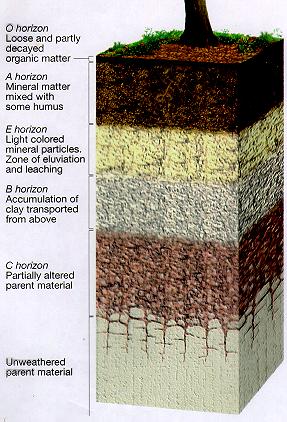Soil Formation and Characteristics
Formation (Including Soil Profile)
Soil is very important, not only because of the mass movements that involve it, but for being the home, food, and water holder for our vegetation. Without vegetation, we would not have a food or oxygen source, so ensuring that soil remains conducive to vegetation growth is essential to our survival and the survival of the environment.
Soil is actually formed by a combination of many things. The main component of soil is weathered rock (see why we had to learn about that!!!). As the rock breaks down and moves by erosion, it is compacted within the earth back into rock in the rock cycle. The first few layers of this broken down rock material make up the essence of soil. Joining the broken down rock is decaying organic (living) matter such as fallen leaves (leaf litter), and dead trees and organisms. Organisms called decomposers live within these layers of soil and help break down the organic material into nutrients that the vegetation can use. The soil contains solids, liquids, and gases! You wouldn't typically think of soil as having a gas as a component...but it is one of the most important. The pores within the soil are necessary to house air, which provides oxygen to the things growing in it! So...if we break it down...the main components of soil are: Organic Matter, Mineral Matter (sand, silt or clay), Water, and Air.
If we dug down and pulled out soil until we hit rock, this is what it may look like (called a soil profile):
Sometimes, the O, A, and E horizons are referred to as just the "A" horizon, but the diagram above shows more detail in distinction, which can be useful. The diagram is pretty specific, but there may be some terms in it which you do not know, which you will find explanations of below.
- Humus - While the top layer (O) is loose, humus, which is found in the "A" layer, is very nutrient rich, but has reached a point of stability. It has mineral matter (weathered rocks) mixed with the organic matter. If you were to walk in a forest and scoop under the leaf litter, you would find black soil. This is humus.
- Leaching - In the "E" horizon, water that passes through the layers on the way to the aquifer or plants will absorb minerals. The absorption of minerals is known as leaching.
Just one more key on the horizons...the lower you go, the more compact the soil is due to pressure...so thus as it goes further and further down, the more "rock-like" it becomes, eventually forming bedrock (Under the "C" layer).
Characteristics of Soil
The following are the important characteristic of soil that you need to know in order to be able to understand how different soils can grow different vegetation.
- Texture - the balance of mineral particles in soil. It is determined by the relative amount of sand, silt, and clay in the soil. Most soil will be a combination of the three in different percentages. The following profile is useful in determining the vitality of the soil:
- Sand particles are the largest soil particles. Water moves through them very easily, so therefore sand is not very good at holding water needed for vegetation.
- Silt particles are the medium-sized soil particles. Water can be held and passed through, making it the best of the three particles for vegetation growth.
- Clay particles are the smallest soil particles. Like a baseball field, sometimes water cannot pass through clay, since it clumps up so much. This make it no ideal for vegetation grwth as well.
- Biotic
components - the term biotic means "living." So, this is going to be the amount of living material in the soil. This will determine the rate at which the organiz matter is present and decomposes.
- Percolation
rate - The rate at which water moves through saturated (wet) granular material. Material with greater percolation rate can usually absorb more water. It is highest in sand and lowest in clay...therefore it increases as particle size increases. Too high of a percolation rate and result in water not being stored within the soil as it runs through too quickly and too low of a percolation rate can result in water being trapped on the surface, and thus not being absorbed in the soil.
- Moisture
Content - The amount of water that is stored in the soil. Goes hand-in-hand with percolation rate, and, of course, the amount of precipitation an area receives. If an area is dry the percolation rate will be quick compared to if the moisture content is high already.
- Porosity - The amount of "empty space" in the soil. This is where air is stored and how water travels through, so it is important to have porous soil. Sand has large spaces between pores, while clay has small spaces, but both can have high porosity at certain conditions.
- Percent
organic matter - this is the ratio of decomposed organic material that is present in the soil. It is important to have a good amount of organic matter, as it is what provides nutrient to the vegetation. Organic matter also provides water-holding capacity, soil structure, and erosion prevention through stability. Too much can be a bad thing...between 5-10% organic matter is usually the standard for success.
- Fertility - Basically describes the ability of the soil to support vegetation and other organic life. Fertile soil will have the following characteristics:
- Nutrient-rich (Nitrogen, Phosphorus, and Potassium)...comes from organic material!
- Will contain minerals needed for plant nutrition, like boron, chlorine, etc.
- Contains organic matter
- pH is between 6.0-6.8
- Well drained with solid structure
- Contains microorganisms that will break down organic material
- Has a good layer of topsoil - the "O" and "A" layers



